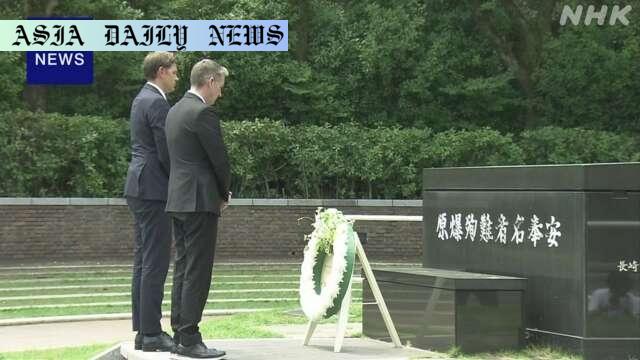Nagasaki: Norwegian Nobel Committee Chair Joergen Frydnes pays respects to the atomic bomb victims and calls for lasting peace.
Nagasaki: Norwegian Nobel Committee Chair Joergen Frydnes visited the atomic bomb site to honor victims and encourage peace.
He emphasized the importance of passing hope and responsibility to future generations amid rising global tension.

Remembering Nagasaki – Honoring Atomic Bomb Victims
On a solemn journey to Japan, Norwegian Nobel Committee Chair Joergen Frydnes offered his heartfelt respects to the victims of the atomic bombing in Nagasaki. As part of his visit, Frydnes took a significant step in commemorating the horrors endured by the people of this historic city. By laying flowers at ground zero, he symbolized the world’s acknowledgment of the tragedy and its commitment to peace.
Frydnes’s visit carries a deeper resonance as it coincides with the global recognition of Nihon Hidankyo, the Japan Confederation of A- and H-Bomb Survivors Organizations. This group was awarded the Nobel Peace Prize last year for their relentless efforts to ensure that the world remembers the devastating impacts of nuclear warfare. Their voice, representing the hibakusha of Hiroshima and Nagasaki, has become a beacon of hope and a potent reminder of the costs of war.
The Journey Through Nagasaki’s History of Pain and Resilience
During his time in Nagasaki, Frydnes visited the Atomic Bomb Museum, where he observed panels and exhibits that chronicle the harrowing experiences of survivors and the lasting efforts of Nihon Hidankyo. One notable display – a moving banner inscribed with messages from survivors – had been taken to Oslo during the Nobel award ceremony, amplifying their voices on an international stage.
At the Nagasaki National Peace Memorial Hall for the Atomic Bomb Victims, Frydnes left a poignant message in the guest book. His words reflected deep respect and an earnest wish for enduring peace. “Here in Nagasaki, a city marked by unimaginable loss, we honor those who died, those who remember, and those who have transformed their suffering into a lasting call for peace,” he wrote, encapsulating the essence of the hibakusha’s legacy.
Lessons for the Present and Future
In his remarks to reporters, Frydnes expressed his profound emotion after listening to testimonials from the survivors. He admitted that their words left him “at a loss for words,” demonstrating the depth of inspiration and sorrow he felt. His visit serves as a stark reminder of the risks humanity faces in an era where the threat of nuclear proliferation persists.
Frydnes stressed the importance of learning from history, especially in a world increasingly beset by uncertainty and turmoil. He passionately urged for hope and resilience as vital tools for the future. His message of spreading responsibility and commitment to future generations resonates even more powerfully in today’s geopolitical climate.
A Call to Global Responsibility
As humanity stands at a crossroads, Frydnes’s appeal for peace transcends borders, races, and nations. Nagasaki’s painful history serves as an everlasting guide to the perils of nuclear warfare and the need for collective action to prevent such devastation from recurring. The Nobel Chair’s act of honoring Nagasaki reflects a universal yearning for a harmonious future.
Ultimately, the visit by Joergen Frydnes underscores not just his personal respect, but the global responsibility to learn, remember, and strive towards a future free from nuclear fear. In the footsteps of Nihon Hidankyo and the hibakusha, there remains hope that such tragedies may only serve as history and not a blueprint for the future.



Commentary
The Weight of History in Nagasaki
As I reflect on Joergen Frydnes’s visit to Nagasaki, I am deeply moved by the deliberate and empathetic gesture he demonstrated in honoring the lives lost and forever impacted by the tragic events of August 1945. His words and actions reignite the importance of remembrance and reconciliation in an increasingly divided world, reminding us all of the devastating consequences of human conflict.
Nagasaki is not just a geographical location; it is a testament to humanity’s resilience and determination to build a better future from the ashes of despair. The hibakusha, who have turned their pain into a mission for peace, embody the spirit of survival and advocacy that we desperately need. Joergen Frydnes’s recognition of their work reflects the growing realization that understanding our past is pivotal to shaping a harmonious future.
Global Relevance of Nagasaki’s Lessons
In today’s world, where discussions around nuclear armament are becoming alarmingly frequent, Nagasaki’s story stands as an essential cautionary tale. The site of unimaginable loss has transformed into a symbol of hope and learning. Frydnes’s visit and his evocative message not only serve to honor victims but also to remind global leaders of their immense responsibility toward fostering peace and stability.
As citizens, we must also absorb these lessons and contribute to creating a world where such tragedies are never repeated. By acknowledging the profound suffering endured by Nagasaki and Hiroshima, the global community can come together to ensure a future rooted in compassion, understanding, and mindful decision-making.
The Role of Individual and Collective Actions
The story of Nagasaki encourages both individuals and nations to reflect deeply on the consequences of their actions. Joergen Frydnes’s visit represents the crucial balance between personal commitment and collective responsibility. It compels us all to question where we stand in contributing towards reducing nuclear threats and fostering an environment of international cooperation.
Frydnes reminds us that preserving peace is not solely the domain of a few leaders or organizations but a shared endeavor that begins with remembering our shared history. His recognition of Nihon Hidankyo’s work emphasizes that ordinary people, galvanized by extraordinary circumstances, have the power to inspire and enact change.